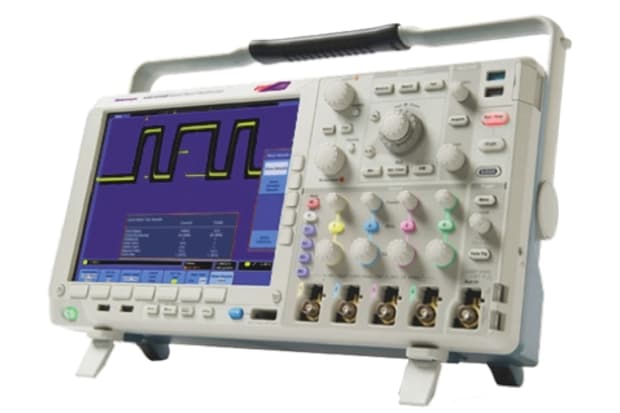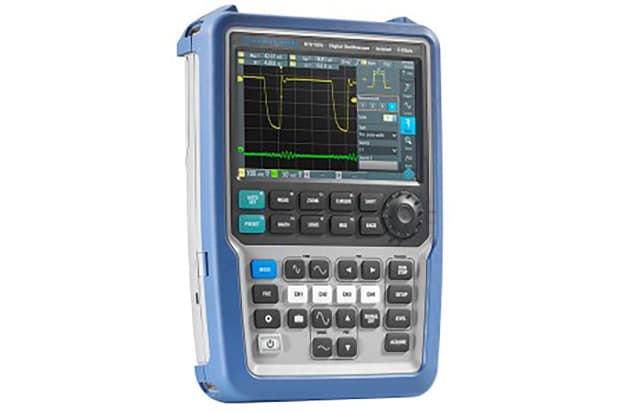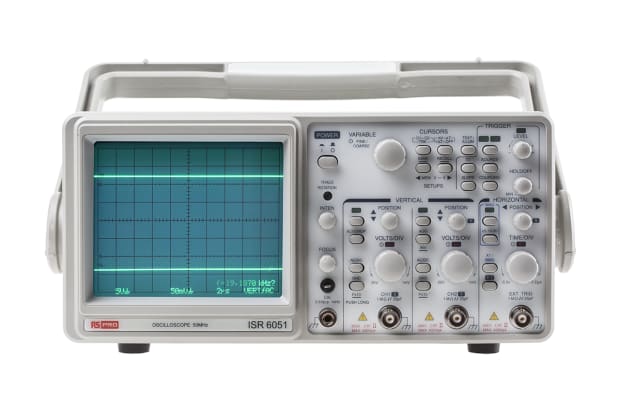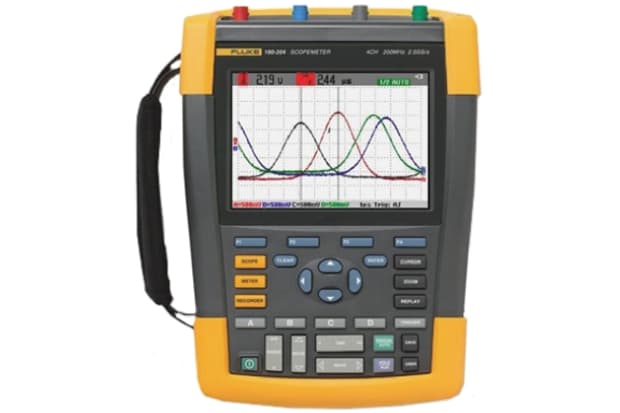- Published Mar 17, 2023
- Last Modified Aug 29, 2023
- 7 min
Oscilloscopes - A Complete Guide
Learn what oscilloscopes are, what they are used for, the types and brands available and how to use them.

What is an oscilloscope? How do they work, and how are the various types used? In this introductory guide, we will explore some of the more popular models and brands of oscilloscope available, and examine some of the ways they are used in various applications to read, monitor and interpret electrical waveform patterns.
What is an Oscilloscope?
An oscilloscope - sometimes referred to as a scope or o-scope - is a key piece of equipment in the toolkits of most electronic design engineers and academic researchers, and a particularly common sight in the consumer technology servicing and repairs industry. Oscilloscopes are considered essential apparatus in the design, testing or maintenance of most types of electronic equipment.
However, although chiefly considered an important item of electrical test and measurement gear, oscilloscopes will also be equally familiar devices to those working regularly in fields that require general monitoring, diagnosis or troubleshooting of any electrically powered circuits, signals and systems. This covers a highly diverse spectrum of roles and environments, including:
- Automotive repair and maintenance
- Sound engineering
- Electronics production and manufacture
- Physics, natural sciences and research
- Healthcare and medicine
What is an Oscilloscope Used for?
Available in various physical formats - handheld, benchtop, or PC-based - oscilloscopes are widely used for general capture, process, display and analysis of detailed information about electronic signal waveforms.
What Does an Oscilloscope Do?
Oscilloscopes relay detailed information about the behaviour of an incoming electrical signal. They do this by displaying the signal as a waveform pattern, which is generally shown on a screen as an animated graph that fluctuates over time. In doing so, a scope greatly expands on the basic functionality of a typical multimeter-type device, allowing users to better understand a range of important signal characteristics such as frequency, noise, and amplitude.
What Does an Oscilloscope Measure?
Oscilloscopes can measure various characteristics of an electrical signal, depending on the device type and the input settings being used, with the fundamental parameters usually being time-based and voltage-based characteristics.
The familiar pattern of an electronic waveform displayed visually as a graph will often sit between an x-axis (horizontal) and a y-axis (vertical). These typically represent time and voltage respectively. In other words, the oscilloscope continually ‘draws’ a graph of instantaneous signal voltage as a function of time.
By giving users the ability to zoom in and out on the resulting waveform pattern as it shifts and fluctuates over time, a scope provides the opportunity for analysis and interpretation of numerous facets of the signal. This often allows for detailed diagnostic assessment of both the signal itself and the various components or items of equipment responsible for generating and carrying it.
Key time-based signal characteristics an engineer might be on the lookout for when purchasing an oscilloscope could include aspects such as bandwidth, sampling rate and memory capacity.
Take a Look for Yourself!
This video provides an overview of one of our RS Pro oscilloscopes, giving you more information on the functionality that a device like this can offer. It also presents the perfect opportunity to see an oscilloscope in action and take a look for yourself.
In our in-house RS Pro range, we have many different types of oscilloscopes including digital storage, hand-held and PC-based.
Types of Oscilloscopes
There are numerous different types of oscilloscope available, with each having its own strengths and abilities in specific scenarios or applications. In addition, a wide range of oscilloscope accessories and add-ons can be purchased, allowing users to enhance many device types with a whole host of extra potential functions and features. However, on a more basic level, there are two key scope types to be aware of first and foremost - namely analogue and digital.
Analogue Display vs Digital Display Oscilloscopes
In short, an analogue oscilloscope displays signal waveforms in their ‘raw’ original format, leaving users to do much of the subsequent interpretive work manually based on various calculations and conversions. A digital oscilloscope, on the other hand, will typically sample the incoming data automatically, and transcribe all the original analogue waveform information into a plethora of useful numerical datasets. In most cases, this offers the user considerably more straightforward and versatile access to a greater range of diagnostic information, cutting out the manual steps and increasing efficiency.
The clear majority of modern oscilloscopes are digital. While analogue models are still available, digital models are generally preferred due to their high levels of accuracy, versatility, and overall ease of use.
Oscilloscope Types
Multiple different types of oscilloscopes are available, including:
- Digital phosphor oscilloscope (DPO): These use a parallel processing architecture to enable capture and display of signals and can simulate some of the features of an analogue scope
- Digital sampling oscilloscopes: These are used for analysing high-frequency signals up to 50 GHz, for example. They can also record waveforms for later analysis
- Mixed domain oscilloscope (MDO): These can be used to capture an analogue signal as well as a digital signal and can also decode serial communication protocols
- Cathode ray oscilloscope (CRO): These are the most traditional type of older analogue oscilloscopes, using cathode ray tubes (CRTs) for signal waveform display
Some additional – and more common – types of oscilloscope are displayed below.
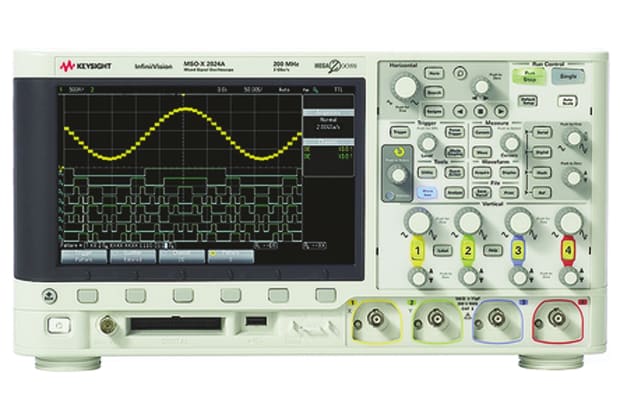
Bench Oscilloscope
These generally denote a larger and more capable unit, often most suitable for use in professional electrical engineering settings, labs, or industrial signal analysis environments.
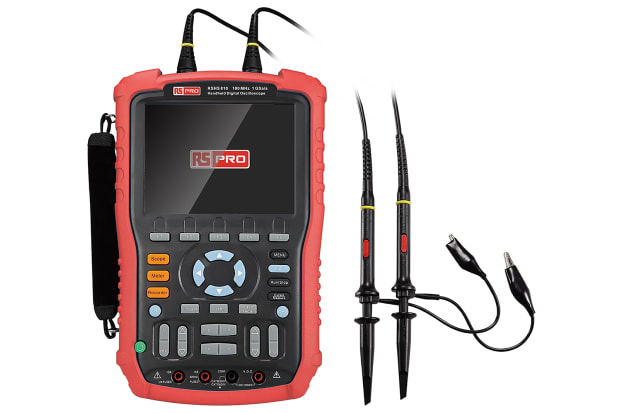
Handheld/Mini Oscilloscope
These are portable pocket-sized or handheld devices, often powered by USB or a similarly low-draw source.
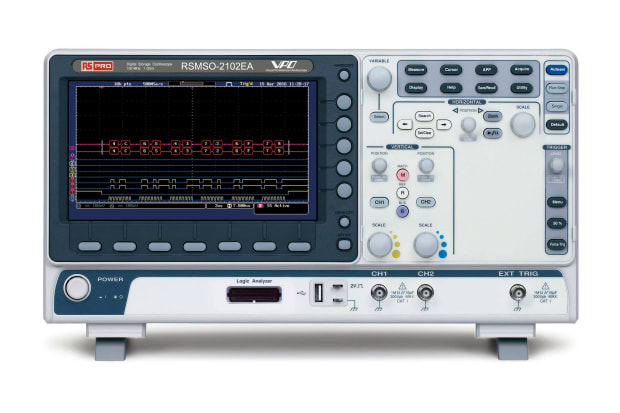
Mixed Signal Oscilloscope (MSO)
A mixed-signal oscilloscope, also known as an MSO, combines a range of core oscilloscope functions with those of a basic logic analyser.

Digital Storage Oscilloscope (DSO)
These include a built-in memory capacity, enabling the storage and display of waveforms over a longer period (even when it is no longer continuous, i.e. actively being generated).
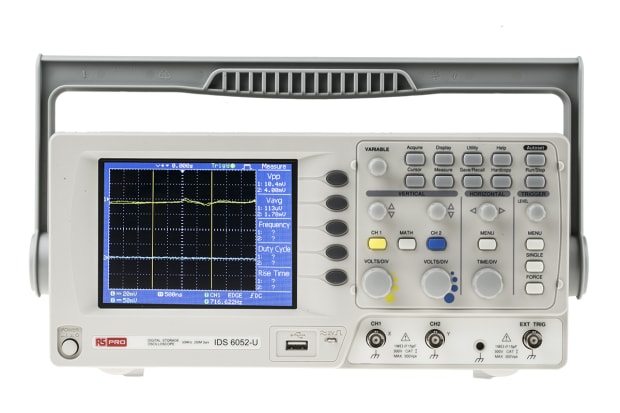
Please note that digital models, such as the increasingly widespread digital storage scope (DSO), provide some valuable benefits in terms of signal analysis capabilities.
Among the most important of these is that DSOs allow for the capture and identification of signal transients (behaviours that occur only once, or very infrequently). All information about the waveform is stored in memory as binary data, so analysis and processing (printing, transferring to computers and external storage, long-term archiving etc) are made much simpler.
Oscilloscope Probes
To detect and measure the electric current flowing through a conductor, an oscilloscope first needs to be connected to the signal source using a probe. The probe is a single-input device and its role is to be touched onto a circuit, to divert the electrical signal to the scope.
Oscilloscope probes must always first be safely grounded before use, using their included clip to connect to a common ground point on the circuit under test. It is good practice for ground leads to be as short as possible as this helps to keep the probe electrically ‘invisible’. This means a reduced impact on signal behaviour due to the probe or wire’s own inherent inductance, capacitance, and resistance characteristics, although there will always be some baseline influence to take into account. Invisibility, and thus minimal impact on the circuit under test, is one of the key goals to keep in mind when using current probes with an o-scope.
Various types of oscilloscope probes are available, with the ideal types for any given setup or scenario depending on various parameters - most importantly, the characteristics of the scope model being used, the type of devices or signal carriers it is being connected to, and the sorts of information about signals and waveforms being sought.
For improved performance and reliability of data, you should always use an appropriate probe tip and probe tip adapter for the equipment and application. When selecting an oscilloscope current probe, you should always ensure first and foremost that the probe’s input connector matches the connector type on the scope. Additionally, you will need to match the input resistance and capacitance of the scope and the probe in question. This is a critical factor in achieving proper signal transfer, and thus the accuracy of any data gathered.
Once a probe with a suitable capacitance has been identified, you can fine-tune the probe’s capacitance by adjusting its compensation network via its trimmer capacitor. This is known as compensating a probe and is usually done by twisting a recessed screw head near the tip of the probe, which in turn is connected to a built-in shunt capacitor.
Passive and Active Probes
Passive probes are among the most commonly used types for taking basic measurements in testing applications. They tend to be fairly easy to use, relatively inexpensive, and reasonably rugged - suitable for use in a wide range of applications and environments.
Passive attenuation probes multiply the voltage measurement range of the oscilloscope using an internal resistor, which allows for the measurement of signals that might otherwise exceed the functional limits of the oscilloscope. Furthermore, the attenuation circuitry found in this type of probe results in higher resistance and lower capacitance, which can be key in accurate measuring of higher-frequency signals.
Some of the most typical configurations of passive probes include:
- 1x: no attenuation
- 10x: factor-of-10 attenuation
- 100x: factor-of-100 attenuation
- 1000x: factor-of-1000 attenuation
Active probes contain active components, such as FETs or amplifiers, and are commonly used for taking high-speed measurements (>500 MHz) or for reading signals on high-impedance circuits. They are almost always externally powered, meaning that they can amplify signals without drawing power from the test circuit, although they tend to have a relatively limited voltage range.
Popular Oscilloscope Brands
Tektronix
Tektronix makes some of the industry’s most-used and trusted bench oscilloscopes. Click here to view their product range.
Rohde & Schwarz
Find out more about the oscilloscopes produced by Rohde & Schwarz, a renowned manufacturer of a wide range of scopes and electronics.
RS Pro
Click through and take a look at our own great-value range of high-quality oscilloscopes.
Fluke
Browse the full range of oscilloscopes available from Fluke, a leading name in various test and measurement fields.
